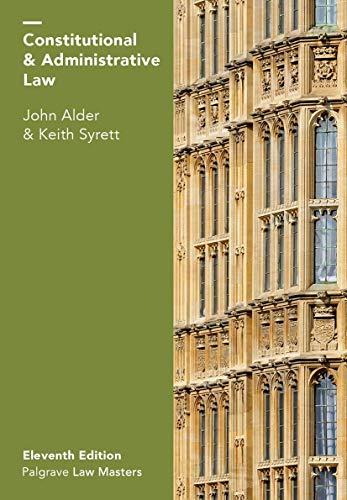Answered step by step
Verified Expert Solution
Question
1 Approved Answer
1. Which of the following prevents a plaintiff from bringing a second lawsuit based on the same facts, parties, and legal issues already decided in
1. Which of the following prevents a plaintiff from bringing a second lawsuit based on the same facts, parties, and legal issues already decided in a prior lawsuit? A. Double jeopardy B. Res judicata C. Full faith and credit D. Immunity 2. A person files suit in federal court against the State of New York, claiming he suffered injuries as a result of the passage of the state's Clean Water Act, which forced him to close down his medical-waste dump and declare bankruptcy as a result of the cleanup costs mandated by the new law. The case is dismissed. Why? A. Federal courts have no jurisdiction in bankruptcy cases. B. New York is protected from being sued by sovereign immunity. C. The suit should have been brought in New York Superior Court. D. The case didn't involve people living in two different states. 3. Bob writes a letter summarizing what he knows about his case and gives it to his attorney. Bob gives a copy of the letter to his wife. The attorney gives the letter to her paralegal, who gives it to the attorney's secretary to be filed. Everyone looks at the letter. Who is not protected by attorney-client privilege from compelled disclosure? A. The wife B. The attorney C. The secretary D. The paralegal 4. An oral examination or questioning of a witness, used to gather information as part of the discovery process, is known as a/an A. disclosure of information. B. deposition. C. interview. D. cross examination. 5. When is the information shared between an attorney and client not confidential? A. When the judge shares the information with another attorney B. When people who aren't a part of the legal team are present C. When other parts of the legal team are present D. When the attorney decides it isn't 6. It may be unfair to sue someone in a county that is far away from the county where that defendant lives or does business. The issue raised in such a situation is A. in personam jurisdiction. B. statute of limitations. C. proper venue. D. subject-matter jurisdiction. 7. Under federal law, federal courts can hear disputes between parties who reside in different states if the damages are worth more than $75,000. This exception is called A. inclusion jurisdiction. B. overruling authority. C. Mann's law. D. diversity jurisdiction. 8. The plaintiff involved in a case must have which means that the plaintiff must demonstrate that he or she suffered or will imminently suffer an injury. A. standing B. a good reputation C. evidence D. an authority agreement Select the best answer for the question. 9. A is a conclusion of fact. A. conclusion B. statement of fact C. binding argument D. Finding 10. A law stating that after a certain amount of time, a plaintiff can no longer bring a claim, even if it has merit, is called A. regulatory indifference. B. defendant limitations. C. a statute of limitations. D. constitutional fairness. 11. How many federal district courts are there? A. 102 B. 76 C. 88 D. 94 12. The Bill of Rights consists of the first amendments to the Constitution that guarantee citizens' basic liberties. A. 10 B. 12 C. 8 D. 6 13. The right against self-incrimination prevents the government from A. attempting to incriminate a defendant who invokes that right. B. calling witnesses who repeat incriminating statements the criminal defendant made. C. requiring the criminal defendant to testify at trial. D. calling the criminal defendant as a witness without first giving a Miranda warning. 14. Investigators in a law firm are ethically permitted to A. interview witnesses and record their observations. B. appear in court on behalf of clients. C. tell the client how to fill out legal forms. D. advise clients on what the law is in their situation. 15. reasoning is logical thinking applied to legal principles. A. Plaintiff B. Attorney C. Legal D. Judge 16. Which of the following is the highest court in the state or federal court system of which it's a part? A. US District Court for the District of Texas B. US Court of Appeals for the Sixth Circuit C. California Supreme Court D. New York Supreme Court 17. due process guarantees that the process of administering the law is fair and that notice is given before the government deprives a citizen of life, liberty, or property. A. Court B. Orderly C. Procedural D. Authoritative 19. Lawyers perform three basics tasks on behalf of clients: counseling, litigating, and A. sentencing. B. negotiating. C. arguing. D. briefing. 20. The Arizona legislature passes a law allowing Mexican immigrants to enter the United States freely and establish residency, directly contravening federal law. After the governor signs the law, what would likely happen next? A. The law would be invalidated based on the preemption doctrine. B. Courts in other states would use the law as precedent when deciding cases involving Mexican immigration. C. Federal district courts in Arizona would be obliged to decide cases based on the new law. D. The law would have to be upheld by the Supreme Court before it could be enforced
Step by Step Solution
There are 3 Steps involved in it
Step: 1

Get Instant Access to Expert-Tailored Solutions
See step-by-step solutions with expert insights and AI powered tools for academic success
Step: 2

Step: 3

Ace Your Homework with AI
Get the answers you need in no time with our AI-driven, step-by-step assistance
Get Started


